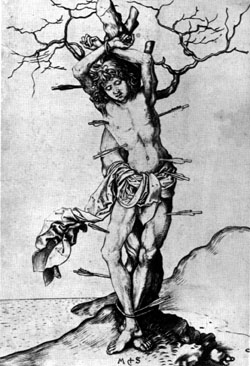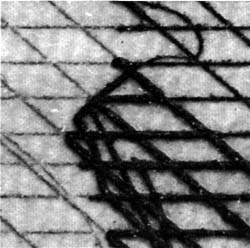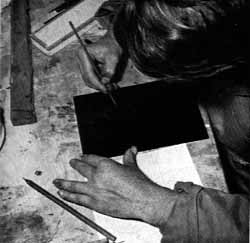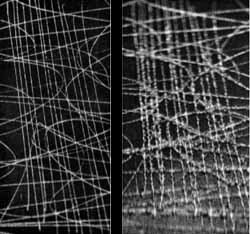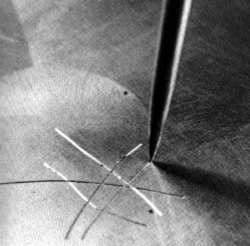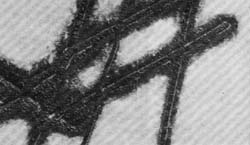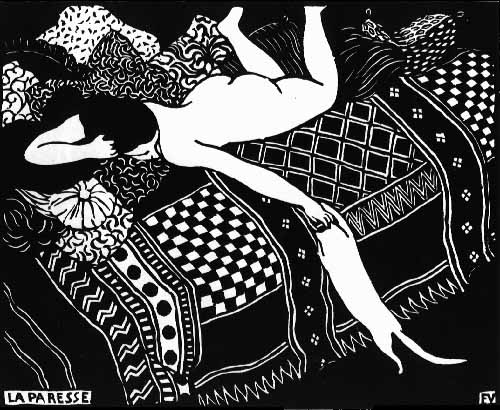|
An etching is a technique in which the artist engraves a metal plate with the help of acid. It comes from a family of numerous printing techniques, some already known in the 15 th century in Europe, where the artist first makes some cuts in a wooden plate, then fills those cuts with inks and press it strongly against a piece of paper, creating a print. First devised to make cheap reproduction possible, it became in the 19th century an art by itself, with artists like Dürer, Rembrandt, Corot, Picasso, Dubuffet and many others who have spend long times mastering this difficult technique. To make prints artists engraves many kinds of materials, and with different methods. Each has a different name, which you should know if you want to talk to art dealers specialised in prints and etchings. |
||||
|
|
|||||
How Etchings are Made |
|||||
|
In the Middle Ages, to reproduce an
image the first method used was to take a piece of oak,
engrave with classical woodworking tools and then cover
it with ink and print hundreds of copies. This is the
classical woodcut. But the wooden plate
is an exigent material, which forgives nothing and has
some constraint due to the constitution of the wood.
Furthermore, the wood weared out during the enormous
editions made in the Middle Ages. Soon jewelers tried to use the delicate ornament they cut in metal for printing. The metal appeared a better choice for that purpose, on many counts.. First, there are many more ways to cut it to the artist's fancy. He may use jeweller's tools, a simple metal point (the etching needle) or even acid. Then the metal wears out far less rapidly when making huge editions. Both methods have been used continually during five centuries, with many variants. Here I will describe the specific method used by Nall to make his etching series of 1982-1984. |
||||
| Nall used copper plates that he first engraved with acid, then corrected it with an etching needle. He made at least two plates for each print (there are two colors). | |||||
|
First a copper plate is covered with a
thin wax coating, made black by holding the plate over a
candle. Then the artist begins to draw freely on this plate, with a metal point that scratches the wax layer. Note that it is much easier for the artist to scratch a thin layer of wax than it would be to engrave directly in the metal. This allows him more spontaneity. |
||||
|
|||||
|
The plate is put in a bath of acid which eats the metal where the artist has scratched the protective wax layer. The remaining wax is then removed, and the engraved metal plate is ready. | ||||
Before Acid |
After Acid |
||||
|
The plate can be printed as is, or be
further worked upon. Nall worked a the dry point, a metal
pen usable with soft metal plates like the copper one he
used for these series. The cuts made with the dry point
are less sinous than those made with the acid method
(aqua forta) and they have very rough edges, especially
during the first prints. Nall repeated this process at least two times for each print, one for each color. |
||||
|
The dry point makes rough edges around the cut (the barbed edges come from the metal removed in the cut). Theses edges pump ink when printing, and they make the clouds of ink you see on the picture left. That's the best way to recognise a dry point work. | ||||
|
The plate is then brought to the printer's shop. Here a specialist spreads some ink on the plate, then rubs it with a piece of cloth to leave ink only in the cuts. A wet sheet of paper is applied on the plate and both are pressed in a manual printing press. This operation is repeated for each color. The prints are finally made to dry, signed and numbered by the artist. Note that normally the plates of contemporary artists are either destroyed or scratched to make further printing impossible. The artist usually keeps some non-numbered prints for himself, the so called Epreuves d'artiste, or EA. | ||||
